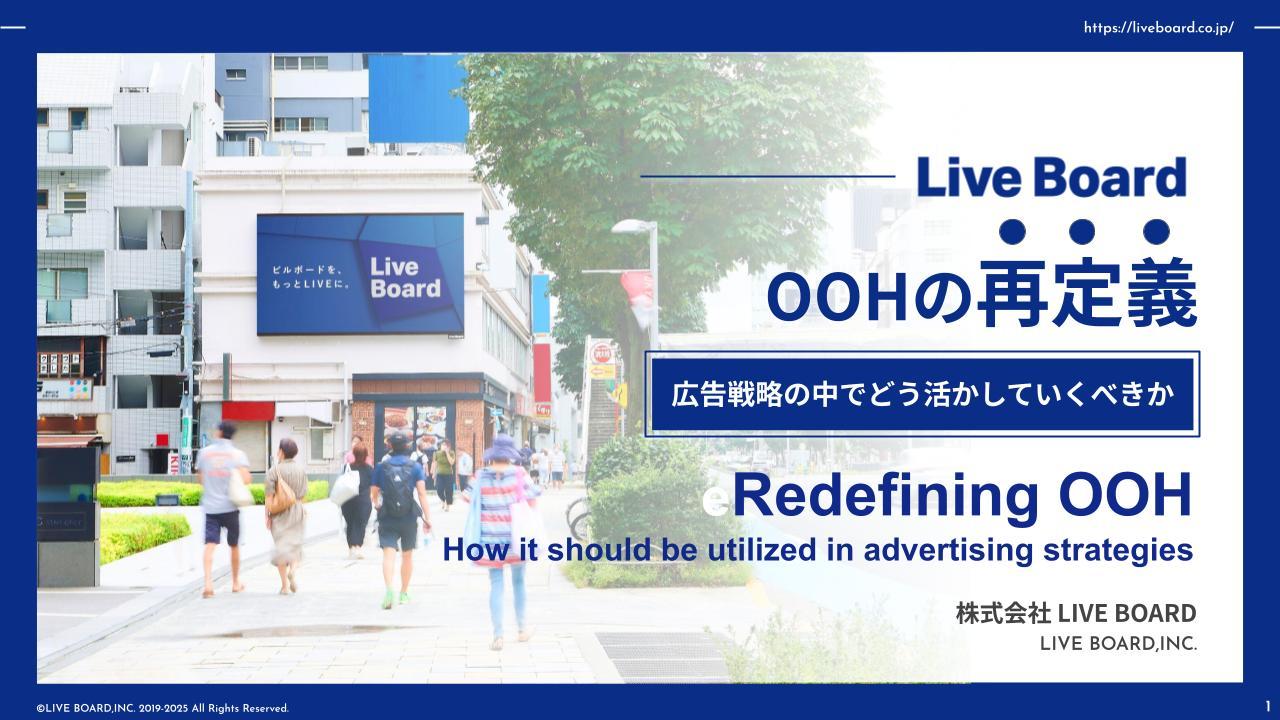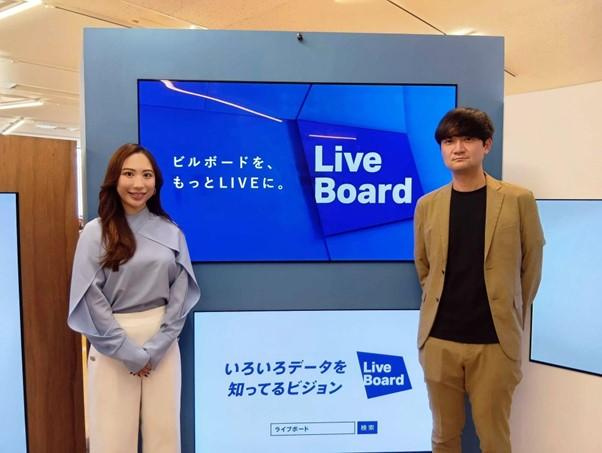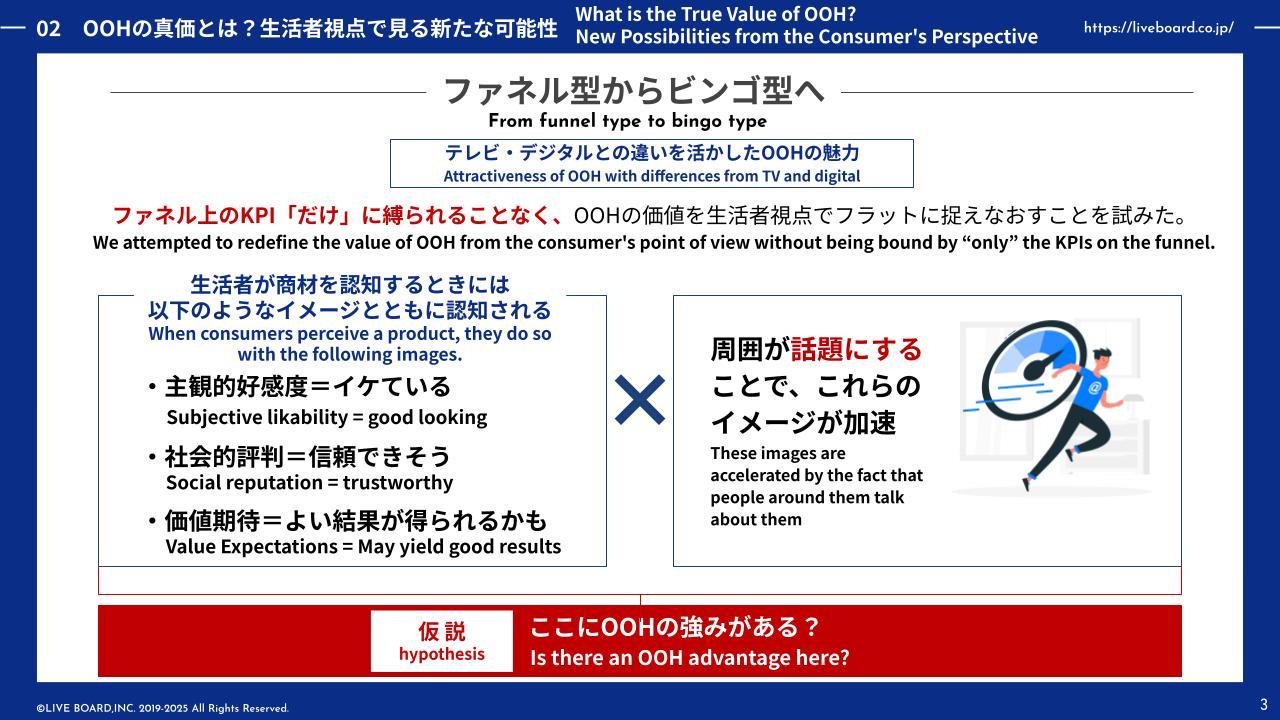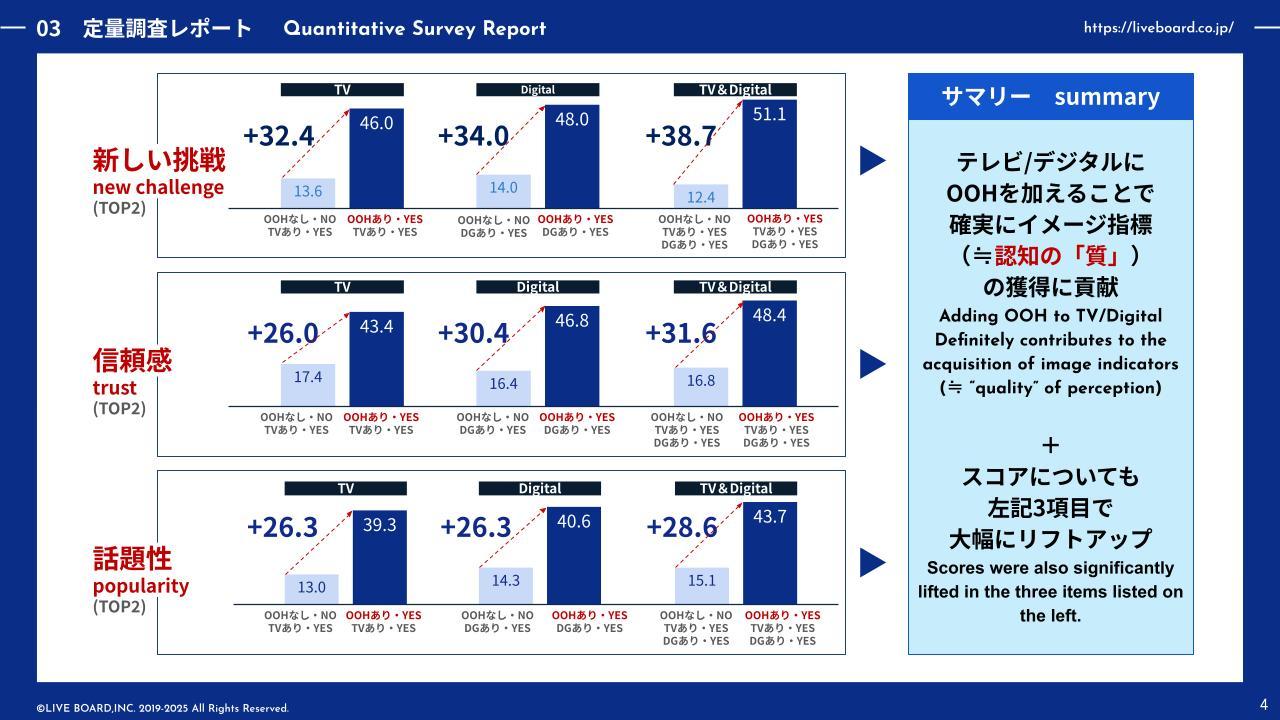Redefining OOH How it should be utilized in advertising strategies

The out-of-home (OOH) market has been growing rapidly in recent years, and the value it provides has increased significantly with the development of high-impact media that symbolize urban landscape and the proliferation of programmatic OOH. While this evolution has led to an increasing number of companies adding OOH to their media communication strategies, there are still many companies that are not fully utilizing OOH, as they are still primarily focused on television and digital media.
In light of this current situation, Dentsu Inc. and LIVE BOARD conducted a survey on the role of OOH in media communication strategies and its potential effects. In this interview, we asked Satoko Arichi of the Business Development Department, OOH Business Management Office, Dentsu, and Hirotaka Mano at LIVE BOARD Insight Department about the survey findings, new insights, and their perspectives on the use of OOH.
 (Pictured left to right.)
(Pictured left to right.)
Satoko Arichi
Business Development Department, OOH Business Management Office, Dentsu Inc.
Hirotaka Mano
Insight Department, LIVE BOARD, Inc.
What is the True Value of OOH?
New Possibilities from consumer's Perspectives
LIVE BOARD, Mano (hereafter, Mano):While considering how OOH could be utilized in future media strategies, we hypothesized that there might be a gap between how OOH consumers andadvertisers perceive OOH.
Dentsu, Ms.Arichi (hereinafter, Ms.Arichi):As a consumer myself, I enjoy OOH and view it positively. However, in my work with advertisers as a sales representative, the focus of media strategy has been remained on TV and digital, and OOH has rarely been considered on an equal footing.
Now that we are in a position to consider OOH sales, we have realized once again that while OOH is favorably received by consumers, it may not be fully appreciated by advertisers. We believe that this gap is one of the reasons why OOH is not easily considered in the early stages of media planning. We also thought that OOH may have an appeal that cannot be captured by conventional indicators.
Mano: Therefore, in order to properly express the value of OOH from the consumer's perspective to the advertisers, we first conducted group interviews with consumer about their perception of media.
Ms. Arichi: The subjects of the group interviews were students, housewives, and working adults with jobs. While there were positive comments about TV, such as "it just catches my eye" and "I can watch it with my family," some said "I have less contact with TV because I watch my smartphone" and "I used to know about new things from TV commercials, but now I search by myself when I am interested. While some said that "the volume of contact is high" and "I can look things up quickly and even make purchases" for digital, others said that "it is hard to leave a lasting impression of the ads" and "I feel like I am being interrupted by the sudden appearance of ads. On the other hand, OOH was "exciting," "I can learn about things I didn't know," and "I can choose which ads I want to see myself.
Ms. Arichi: Television and digital media can deliver information to the target audience, but people who live surrounded by a large amount of information tend to have the impression that they do not consciously try to watch it or feel that it is taking up their time.
These results indicate that advertisers want to "deliver information to the target audience without fail and achieve KPIs! while consumers want to select information that is necessary for them or that enriches their lives.
Mano: With regard to OOH, I think it can be said that it is a medium that is easily accepted by consumer due to its characteristics such as "a sense of excitement" and "the ability to carefully view advertisements that one wants to see. We felt that this suggests the possibility of converting negative impressions often held by TV and digital media into positive ones.
OOH is a medium that can incorporate the brand's context into the cityscape. From a consumer's point of view, the streets and trains that we usually visit without thinking, such as Shibuya station and the Yamanote line, can be a place of new stimulation and awareness, such as "Suddenly it looks like this! This is a place of new stimulation and awareness. This is an experience that cannot be created by individual consumers, and is a unique attraction of OOH.
From Funnel to Bingo
OOH Attraction with TV/Digital Difference
Ms. Arichi: Today, consumers are able to obtain information through optimal recommendations and are becoming less dependent on advertising. In the past, it was possible to predict consumer behavior patterns to some extent with a "funnel-type" media strategy, but now it is difficult to predict due to the diversification of the media like a "bingo-type" media, and it is increasingly necessary to match consumers with various points of contact. It is said to be a "bingo-type" media strategy. In light of this, we have decided to rethink OOH from the consumer's point of view and not be bound by the KPI on the funnel as a media strategy suitable for the current era.
Mano: Values that are difficult to express in funnel KPIs include "subjective favorability," such as "This is cool! Social reputation, such as "trustworthy," and value expectation, such as "I'll get good results if I use this," are values that are difficult to express in funnel KPIs. Consumers perceive products and brands based on these values, and OOH may have the power to improve these indicators, so we conducted a quantitative study on these axes for a large-scale campaign using TV, digital, and OOH.
OOH may have an image of advertising effectiveness that is difficult to measure, but LIVE BOARD's Asking Survey makes it possible to visualize the potential of OOH in an "accurate" and "noise-free" manner. This survey utilizes Docomo's privacy-protected location data, etc., to extract ID-based information on people who came in contact with OOH ads during the period they were displayed. Furthermore, by matching these IDs in the survey, questionnaires can be sent to "people who are likely to have seen the ads" and target those who responded that they "saw the ads" on an awareness basis as well.
Ms. Arichi: The results of this survey show that "Do you feel this ad is taking on a new challenge?" the number of respondents who answered "Yes (TOP 2)" was 12.4 points for TV/digital-only contacts, while 51.1 points for TV/digital and OOH contacts. When asked, "Do you consider yourself trustworthy?" the difference between TV/Digital-only contacts was 16.8 points compared to 48.4 points for TV/Digital and OOH contacts, a difference of more than 30 points in both cases.
Ease of acceptance by consumers is key
OOH is the key to next-generation communication strategy
Mano: This significant increase in score indicates that the addition of OOH improves the "quality" of awareness and increases the credibility and likability of the brand, and that OOH together is not only a complement to the two major media, TV and digital, but also a more powerful and effective media. It can be said that OOH is not only complementary to the two major media, TV and digital, but also more effective.
As an advertiser, it is natural to want to ensure that advertisements for which you have spent production costs are delivered to the target audience. Based on a funnel-type media strategy, it is understandable that television and digital media would be the main focus when the KPI is to ensure the delivery of information. However, in today's world of massive amounts of information, consumer behavior has become more complex, and it is important for advertisements to be receptive to this complexity.
Future advertising strategies must consider not just exposure but also how to build brand resonance and emotional connection. In this regard, we are confident that OOH will continue to be a medium that can contribute to advertisers' media communications.
In order to maximize OOH's natural points of contact with consumers, it is ideal to incorporate OOH along with TV and digital from the initial stages of media strategy. LIVE BOARD will continue to strive to unlock the potential of OOH and visualize its value in order to maximize advertisers' media communications.
(Text:Aoi Mitani)
